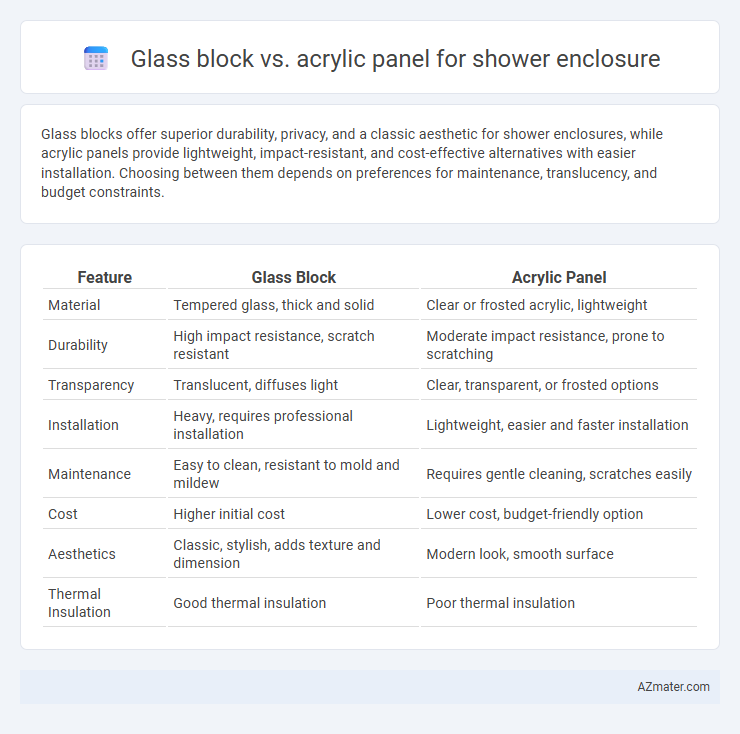Glass blocks offer superior durability, privacy, and a classic aesthetic for shower enclosures, while acrylic panels provide lightweight, impact-resistant, and cost-effective alternatives with easier installation. Choosing between them depends on preferences for maintenance, translucency, and budget constraints.
Table of Comparison
| Feature | Glass Block | Acrylic Panel |
|---|---|---|
| Material | Tempered glass, thick and solid | Clear or frosted acrylic, lightweight |
| Durability | High impact resistance, scratch resistant | Moderate impact resistance, prone to scratching |
| Transparency | Translucent, diffuses light | Clear, transparent, or frosted options |
| Installation | Heavy, requires professional installation | Lightweight, easier and faster installation |
| Maintenance | Easy to clean, resistant to mold and mildew | Requires gentle cleaning, scratches easily |
| Cost | Higher initial cost | Lower cost, budget-friendly option |
| Aesthetics | Classic, stylish, adds texture and dimension | Modern look, smooth surface |
| Thermal Insulation | Good thermal insulation | Poor thermal insulation |
Introduction to Shower Enclosure Materials
Glass blocks offer robust durability, excellent light diffusion, and high privacy for shower enclosures, making them ideal for creating a solid, textured barrier. Acrylic panels provide a lightweight, cost-effective alternative with greater flexibility, easy installation, and simple maintenance, ensuring a sleek, smooth surface. Both materials are popular choices for modern bathroom designs, but glass blocks excel in aesthetic appeal and insulation, while acrylic panels shine in versatility and impact resistance.
Overview of Glass Block Shower Enclosures
Glass block shower enclosures offer a durable and visually appealing option, featuring thick, textured glass blocks that provide privacy while allowing natural light to filter through. These blocks are highly resistant to moisture, scratches, and impacts, making them ideal for wet environments like bathrooms. Their modular design enables custom shapes and sizes, providing both structural support and aesthetic versatility compared to acrylic panels.
Overview of Acrylic Panel Shower Enclosures
Acrylic panel shower enclosures offer lightweight durability and greater impact resistance compared to glass blocks, making them easier to install and less prone to cracking. These panels provide a seamless, customizable design with a smooth surface that resists mold and mildew, enhancing bathroom hygiene. Acrylic panels also deliver better insulation properties and greater flexibility in shapes and sizes for modern shower enclosure designs.
Visual Appeal and Design Flexibility
Glass blocks offer a timeless, textured appearance that diffuses light while providing privacy, enhancing the shower enclosure's visual appeal with a classic, sculptural effect. Acrylic panels deliver superior design flexibility, available in a wide array of colors, patterns, and sizes, allowing for customized aesthetics and seamless integration with modern bathroom styles. Both materials provide durable options, but acrylic's lightweight nature enables easier installation and creative design variations without sacrificing clarity or brightness.
Privacy and Light Transmission Comparison
Glass blocks provide superior privacy due to their textured surface that distorts visibility while allowing substantial natural light to transmit, enhancing bathroom brightness without compromise. Acrylic panels offer varying levels of privacy depending on thickness and finish, but generally allow more direct light transmission, which can reduce privacy compared to glass blocks. For optimal privacy and diffused light, glass blocks outperform acrylic panels in shower enclosures.
Durability and Maintenance Requirements
Glass blocks for shower enclosures offer superior durability due to their resistance to scratches, heat, and moisture, making them a long-lasting choice with minimal risk of cracking. Acrylic panels, while lighter and more flexible, are prone to scratching and yellowing over time, requiring more frequent cleaning and replacement. Maintenance for glass blocks involves simple wiping to prevent mold in grout lines, whereas acrylic panels need careful cleaning with non-abrasive products to avoid surface damage.
Installation Process: Glass Block vs Acrylic Panel
Glass block installation requires precise alignment and mortar application, making it a labor-intensive process that often demands professional expertise and more time to ensure structural stability and waterproofing. Acrylic panels offer a streamlined installation with lightweight, pre-fabricated sheets that can be quickly cut, fitted, and secured using adhesive or screws, reducing labor costs and time significantly. The choice between these materials depends heavily on project timelines, labor skill level, and the desired durability of the shower enclosure.
Cost Analysis and Budget Considerations
Glass blocks typically present higher upfront costs due to material and installation expenses, averaging around $30 to $50 per square foot. Acrylic panels offer a more budget-friendly alternative, often costing between $15 to $25 per square foot, with easier DIY installation reducing overall expenses. Long-term maintenance costs also favor glass blocks, which resist scratches and discoloration better than acrylic, making them a cost-effective option in durable performance for shower enclosures.
Mold, Mildew, and Water Resistance
Glass blocks offer superior mold and mildew resistance due to their non-porous surface that prevents water absorption, making them ideal for shower enclosures exposed to constant moisture. Acrylic panels, while water-resistant, are more prone to scratching and can develop micro-abrasions that harbor mold and mildew if not properly maintained. The inherent durability and impermeability of glass blocks ensure a long-lasting, hygienic barrier against water damage compared to the relatively softer and more porous acrylic panels.
Choosing the Best Option for Your Bathroom
Glass blocks offer superior durability, thermal insulation, and a timeless aesthetic, making them an excellent choice for creating a bright, private shower enclosure. Acrylic panels provide lightweight, impact-resistant, and affordable alternatives with greater design flexibility and easier installation. Evaluating bathroom size, maintenance preferences, and budget helps determine whether the solidity of glass blocks or the versatility of acrylic panels best suits your shower enclosure needs.

Infographic: Glass block vs Acrylic panel for Shower enclosure
 azmater.com
azmater.com